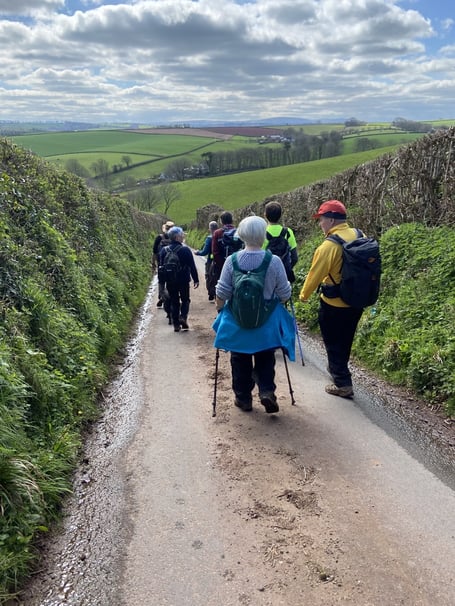The ramblers’ walk on Sunday, April 2, started from Bow, the geographical centre of Devon. Twenty-two members joined this 9.5 mile walk, although six walkers detoured for a shorter route. It was initially cloudy but members were soon stripping off layers in the spring sunshine. As could be expected on this walk around quiet Mid-Devon country lanes, farmland and footpaths, there was plenty of mud and all agreed it was probably the muddiest walk they have done this season. Bow parish comprises just under 3,000 acres of undulating, rich, red farmland and grasslands.
Since 1859, and as a result of the generosity of William Packer of Bow the village is one of approx. 140,000 communities in the UK enjoying its own private water supply. In his Will of August 25 1855, Packer bequeathed £400 to construct the waterworks for Bow. In 1907 the waterworks became regulated by the Charity Commissioners of Bow and by 1911 the charity had an income from householders of £15.10s covering maintenance costs.
During the English Civil War (1642 to 1652) Charles I stayed overnight in Bow when he was chasing the Earl of Essex into Cornwall. A fascinating web-page The Medical Gentlemen of Bow gives the history of surgeons in the parish from the 18th century (https://www.medicalgentlemen.co.uk). This first entry was not an auspicious start for the medical gentlemen. In April 1762 a warrant was put out for the arrest of Stafford Bryet ‘Surgeon of Bow’. He was reputed to have fathered William, son of Elizabeth Nicholls of Bow. The baby was illegitimate and likely to be chargeable to the Bow parish rate. Bow records confirm that a ‘Base Child of Elizabeth Nicholls was baptised there on 16 May 1762’.
The route out of Bow took the walkers past Grade II listed West Halse on to join a short stretch of the Devonshire Heartland Way towards Clannaborough, a long distance route of 43 miles between Okehampton and the village of Stoke Canon just north of Exeter (https://ldwa.org.uk). The route links to the Tarka Trail at North Tawton and follows the Two Moors Way in places. The tiny St Petrock Church in Clannaborough is unusual in not having any aisles. The walkers continued on their way towards Courteneys passing Copplestone cemetery. One eminent son of Copplestone was Walter Browne 1868-1919. Born near Copplestone he moved to Exeter at the age of 10. He was an apprentice wholesale wool merchant latterly becoming a senior partner in another firm in the same business. He became a local Conservative councillor in St Leonards Exeter and deputy mayor in 1913-14. Reaching Broomhill Cross the group continued walking a quiet lane turning again onto the Devonshire Heartland Way/Two Moors Way passing Paschoe House.
Although the Paschoe Estate dates back to the thirteenth century, the original house had to be pulled down due to problems with subsidence. It was replaced with the present house designed by John Hayward and completed in the 1850s. It was for a time a stylish country house retreat and wedding venue but only the restaurant remains open now for part of the week.
The return to Bow was via Appledore Farm and Blackpool Cross. As ever, new walkers are always welcome. You should be suitably attired for all weather conditions, including sturdy footwear and bring a drink and a packed lunch. Meet at the post office in George Street, Okehampton on Sundays ready to leave at 9.30am. Next week, Easter Sunday , the walk will be a local one begining at the post office.





Comments
This article has no comments yet. Be the first to leave a comment.